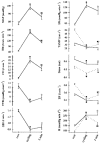Mesenteric, coeliac and splanchnic blood flow in humans during exercise
- PMID: 9824727
- PMCID: PMC2231328
- DOI: 10.1111/j.1469-7793.1998.907ba.x
Mesenteric, coeliac and splanchnic blood flow in humans during exercise
Abstract
1. Exercise reduces splanchnic blood flow, but the mesenteric contribution to this response is uncertain. 2. In nineteen humans, superior mesenteric and coeliac artery flows were determined by duplex ultrasonography during fasting and postprandial submaximal cycling and compared with the splanchnic blood flow as assessed by the Indocyanine Green dye-elimination technique. 3. Cycling increased arterial pressure, heart rate and cardiac output, while it reduced total vascular resistance. These responses were not altered in the postprandial state. During fasting, cycling increased mesenteric, coeliac and splanchnic resistances by 76, 165 and 126 %, respectively, and it reduced corresponding blood flows by 32, 50 and 43 % (by 0.18 +/- 0.04, 0.42 +/- 0.03 and 0.60 +/- 0.04 l min-1). Postprandially, mesenteric and splanchnic vascular resistances decreased, thereby elevating regional blood flow, while the coeliac circulation was not influenced. Postprandial cycling did not influence the mesenteric resistance significantly, but its blood flow decreased by 22 % (0.46 +/- 0.28 l min-1). Coeliac and splanchnic resistance increased by 150 and 63 %, respectively, and the corresponding regional blood flow decreased by 51 and 31 % (0.49 +/- 0.07 and 0.96 +/- 0.28 l min-1). Splanchnic blood flow values assessed by duplex ultrasound and by dye-elimination techniques were correlated (r = 0.70; P < 0.01). 4. During submaximal exercise in humans, splanchnic resistance increases and blood flow is reduced following a 50 % reduction in the hepato-splenic and a 25 % reduction in the mesenteric blood flow.
Figures



References
-
- Appel PL, Kram HB, Mackabee J, Fleming AW, Shoemaker WC. Comparison of measurements of cardiac output by bioimpedance and thermodilution in severely ill surgical patients. Critical Care Medicine. 1986;14:933–935. - PubMed
-
- Bland JM, Altman DG. Statistical methods for assessing agreement between two methods of clinical measurement. Lancet. 1986;i:307–310. - PubMed
-
- Eriksen M, Waaler BA. Priority of blood flow to splanchnic organs in humans during pre- and post-meal exercise. Acta Physiologica Scandinavica. 1994;150:363–372. - PubMed
-
- Evans DH, McDicken WN, Skidmore R, Woodcock JP. Doppler Ultrasound. Physics, Instrumentation, and Clinical Applications. New York: John Wiley & Sons; 1989. pp. 162–205.
Publication types
MeSH terms
Substances
LinkOut - more resources
Full Text Sources
Other Literature Sources
Medical
Miscellaneous

